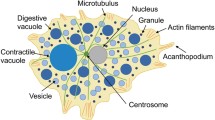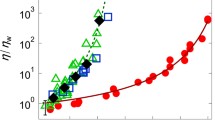Abstract.
We applied a recently developed microrheology technique based on colloidal magnetic tweezers to measure local viscoelastic moduli and active forces in cells of Dictyostelium discoideum. The active transport of nonmagnetic beads taken up by phagocytosis was analyzed by single particle tracking, which allowed us to measure the length of straight steps and the corresponding velocities of the movements. The motion consists of a superposition of nearly straight long-range steps (step length in the micrometer range) and local random walks (step widths about 0.1 µm). The velocities for the former type of motion range from 1 to 3 µm/s. They decrease with increasing bead size and are attributed to rapid active transport along microtubuli. The short-range local motions exhibit velocities of less than 0.5 µm/s and reflect the internal dynamics of the cytoplasm. Viscoelastic response curves were measured by application of force pulses with amplitudes varying between 50 pN and 400 pN. Analysis of the response curves in terms of mechanical equivalent circuits yielded cytoplasmic viscosities varying between 10 and 350 Pa s. Simultaneous analysis of the response curves and of the bead trajectories showed that the motion of the beads is determined by the local yield stress within the cytoplasmic scaffold and cisternae, which varies between σ=30 Pa and 250 Pa. The motion of intracellular particles is interpreted in terms of viscoplastic behavior and the apparent viscosity is a measure of the reciprocal rate of bond breakage within the cytoplasmatic network. The viscoelastic moduli are interpreted as dynamic quantities which depend sensitively on the amplitude of the forces, and the rate of bond breakage is determined by the Arrhenius-Kramers law with the activation energy being reduced by the work performed by the applied force. In agreement with previous work, we provide evidence that the myosin II-deficient cells exhibit higher yield stresses, suggesting that the function of myosin II as a cross-linker is taken over by the other (non-active) cross-linkers.
Similar content being viewed by others
Author information
Authors and Affiliations
Additional information
Revised version: 14 December 2000
Electronic Publication
Rights and permissions
About this article
Cite this article
Feneberg, W., Westphal, M. & Sackmann, E. Dictyostelium cells' cytoplasm as an active viscoplastic body. Eur Biophys J 30, 284–294 (2001). https://doi.org/10.1007/s002490100135
Received:
Accepted:
Issue Date:
DOI: https://doi.org/10.1007/s002490100135




